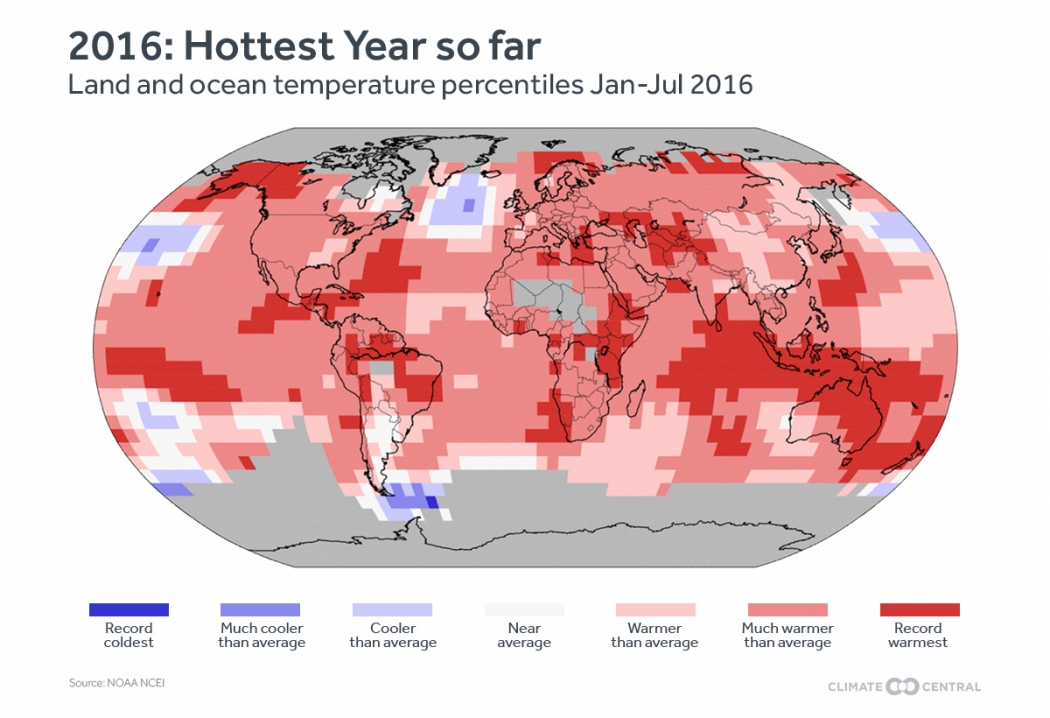
Marrakesh, Morocco | AFP |
Diplomats from 197 nations wound down a two-week UN conference Friday which started drafting a blueprint for arresting global warming “well below” two degrees Celsius (3.6 Fahrenheit) over pre-industrial levels.
A rash of recent climate studies have highlighted the stakes.
Record temperatures
Earth is on track for its third successive year of highest-ever average surface temperatures since records began in 1880.
The first 10 months of the year have been the hottest in modern times.
The average temperature for the year was set to reach 1.2 Celsius (2.16 degrees Fahrenheit) over pre-Industrial Revolution levels — meaning that 16 of the 17 hottest years on record were this century.
For the first time ever, the average temperature in 2015 was a full degree Celsius above the pre-industrial era benchmark used by the UN climate science panel.
In the Arctic, land surface temperatures in 2015 matched the record years of 2007 and 2011, both of which were 2.8 C higher than a century earlier, when records for the region began.
Greenhouse gases
The atmospheric concentration of the three most potent greenhouse gases — carbon dioxide (CO2), methane (CH4), and nitrous oxide (N2O) — all hit new highs in 2015, though the rate of emissions has been nearly flat for three years in a row.
Methane levels, according to a new assessment, may be twice as high as previously thought.
For the first time, the concentration of CO2 — by far the dominant greenhouse gas — stayed above 400 parts per million (ppm) throughout 2015, as measured at the Mauna Loa Observatory on the island of Hawaii.
CO2 levels are going up by just over two parts per million — about half a percent — every year.
Most climate scientists agree that CO2 concentrations must be capped at 450 ppm to have a fighting chance of preventing the global thermometer from rising by more than 2C above the pre-industrial benchmark.
Arctic Ocean in danger
High-altitude glaciers declined in surface area in 2015 for the 36th year in a row.
The Greenland ice sheet lost nearly two trillion tonnes of ice mass between 2003 and 2013.
Arctic Sea ice shrank to 4.14 million square kilometres (1.6 million square miles) on September 16 — the second-lowest after 2012 when it reached 3.39 million km2.
The Arctic Ocean could be entirely ice free in summer as early as 2030.
Sea levels rising
Oceans continued to rise in 2015, reaching a level 70 millimetres (2.75 inches) above the 1993 mark. That works out to about 3.3 mm (0.13 inches) per year, though in parts of the Pacific and Indian Oceans it is more than that.
The pace of sea level rise is likely to pick up in coming decades as ice sheets and glaciers shed mass, threatening the homes and livelihoods of tens of millions of people in low-lying areas around the world.
On current trends, greenhouse gas emissions could cause the Antarctic ice sheet to retreat sufficiently by 2100 to lift global oceans by a metre, double previous estimates.
Extreme events
Some scientists have calculated that the number of climate-related extreme events — droughts, forest fires, floods, major storm surges — have doubled since 1990.
Climate change have boosted the intensity of typhoons battering China, Taiwan, Japan and the Korean Peninsula since 1980 by 12 to 15 percent, according to one recent study.
Natural disasters drive at least 26 million people into poverty each year and cause more than $500 billion (470 billion euros) in lost consumption, according to a World Bank report.
1,688 species affected
Of the 8,688 species of animals and plants listed as “threatened” on the International Union for the Conservation of Nature’s (IUCN) Red List, 19 percent — 1,688 species — have been negatively affected by climate change.
The Great Barrier Reef off Australia’s east coast saw it’s worst-ever episode of coral bleaching earlier this year.
A rise in temperature of more than 1.5 C will trigger a destabilisation of ecosystems in the Mediterranean basin not seen in 10,000 years, according to a recent study.
 The Independent Uganda: You get the Truth we Pay the Price
The Independent Uganda: You get the Truth we Pay the Price


